World News
What to watch out for with bar charts claiming who can win your seat


By Kate Lamble, More or Less, BBC Radio 4
 Getty Images
Getty ImagesIt’s a two-horse race and rival parties can’t win here. That’s the claim you often see on political leaflets, often with a bar chart appearing to back it up. But can you trust it?
This is about tactical voting: for instance, the Liberal Democrats trying to get Labour voters or Green voters to back them to get the Conservatives out, or vice versa.
The use of these tactical messages is on the rise, according to Professor Caitlin Milazzo from the University of Nottingham. Around half of leaflets seen this year by Prof Milazzo’s Open Elections project contain tactical messages, up from 25% in the 2019 general election.
But not all bar charts are created equal. Parties often use data from totally different sources to back up claims that they are in the running. Here are some of the tactics to watch out for.
Mixing and matching
That rise in tactical messaging is being driven by all the political parties, but it is most popular with the Lib Dems. Around 90% of their leaflets contain tactical messages compared to less than one in 10 Conservative leaflets, according to Prof Milazzo.
In Central Devon, the Lib Dems have taken a particularly creative approach to this. On one leaflet submitted by a listener of BBC Radio 4’s More Or Less, a bar chart shows parties’ vote shares in the seat. Rather boldly, there is no bar representing the Conservatives, who have held Central Devon since it was created in 2010.
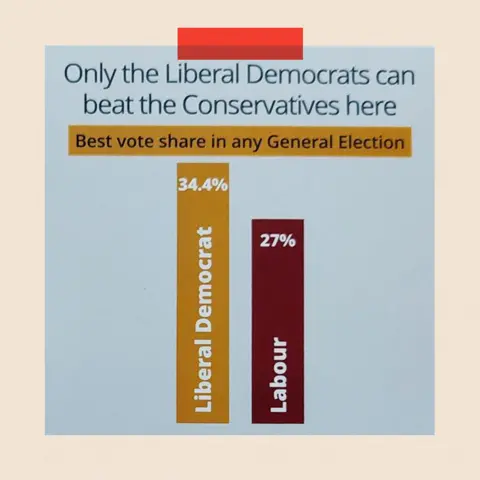
The graphic shows a vote share of 33.4% for the Liberal Democrats in the constituency – but not the year this was achieved, which was in fact 2010. This is set against 27% for Labour, which was received in 2017.
These are, as the leaflet claims, the numbers which represent these parties’ best vote shares in this seat in any general election.
However, there is no mention of the fact that the Lib Dems have come either third or fourth in Central Devon in the past three general elections.
Liberal Democrat headquarters told us: “This leaflet is trying to make the valid point that the Liberal Democrats are the party that has come closest to beating the Conservatives in this seat, however clumsily this locally produced leaflet makes the point, and we will be advising them to follow our best-practice guidelines in future.”
Party like it’s 2019
Many leaflets rely on results from the last UK general election. Sounds simpler, right? There are, however, still two problems with this approach.
Firstly, the popularity of parties has shifted significantly since 2019. And secondly, ahead of this election, most constituencies have had their boundaries redrawn.

What’s going on with the bar charts that political parties put on constituency campaign leaflets? More or Less investigates some of the numbers in the news.

The changes are small in more than half of those seats, but some have been made bigger, smaller or have been broken up. Take the constituency of Stone in Staffordshire which has now been split between five successor constituencies.
Professor Chris Hanretty from Royal Holloway University suggests boundary changes have meant some constituencies like Wimbledon in south London have become somewhat more of a three-way contest, making it more difficult to predict the results.
That’s perhaps how neighbouring party offices can appear to offer such different views on the race this time around.
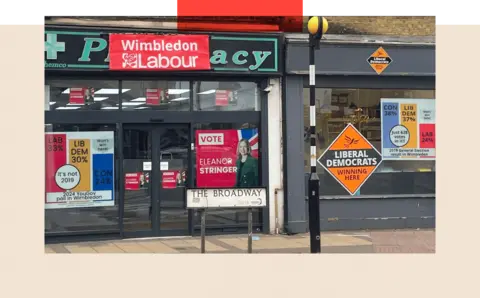
The poster in the Lib Dems’ window shows the 2019 result in Wimbledon, in which they were 628 votes behind the Conservatives. Labour, meanwhile, has a bar chart putting them in the lead, based on polling data – we’ll come to that tactic shortly.
Local votes for local people
Some parties have chosen to base their bar charts on this year’s local election results.
But local elections can be an unreliable guide, according to Prof Hanretty, because people vote very differently in them than in general elections.
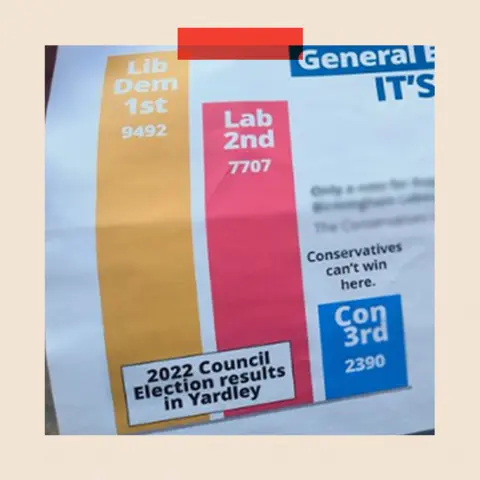
For instance, a Lib Dem leaflet shows the party ahead in Birmingham Yardley constituency based on 2022 local elections. Labour countered that the Lib Dems had come third in the past two general elections.
Voters are also much more likely to support independent candidates in polls for local councils, for instance.
So while local elections can offer a guide as to which parties are active in any area, they bear only limited comparison to the national picture.
Straw polls
A final option is to look at what the opinion polls are saying. However, these are always a snapshot of opinion, and a lot can change during an election campaign.
In Eastleigh, Hampshire, Labour have a bar chart suggesting they are projected to place second behind the Liberal Democrats but ahead of the Conservatives. It says this is based on current YouGov polling applied to the constituency.
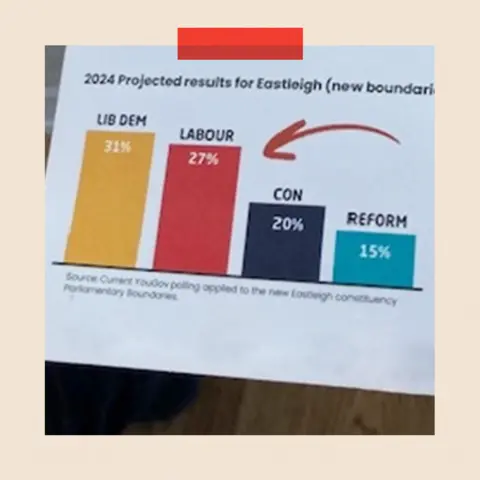
Contrast that with a Lib Dem leaflet circulated in the same seat. The Lib Dems have relied on the previous general election results to show themselves behind the Conservatives – although the size of the bars exaggerates how well their party performed.
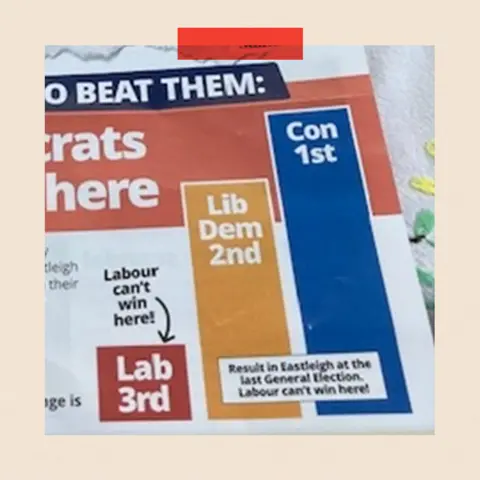
Prof Hanretty has compared Labour’s claim to the most recent YouGov multi-level regresson and post-stratification polls (MRPs) – which apply large national survey samples to project results in individual constituencies.
These give a completely different result – Labour 10 points behind both the Conservatives and the Lib Dems. With regards to what is printed on the Labour leaflet, he says he is “very confused about the basis for that claim, and I follow these things quite closely”.
Labour pointed to an entirely different model run by an independent software developer based on a universal swing across the country. That did show the party ahead in Eastleigh.
It just goes to show there are lots of different possible numbers you can point to to support a message of tactical voting – and parties will pick whichever suits them.
So voters be warned: if you’re looking for the perfect chart, you can’t win here.
BBC InDepth is the new home on the website and app for the best analysis and expertise from our top journalists. Under a distinctive new brand, we’ll bring you fresh perspectives that challenge assumptions, and deep reporting on the biggest issues to help you make sense of a complex world. And we’ll be showcasing thought-provoking content from across BBC Sounds and iPlayer too. We’re starting small but thinking big, and we want to know what you think – you can send us your feedback by clicking on the button below.
World News
Holly Jackson: ‘Obviously, I love murder

 Holly Jackson
Holly JacksonBestselling author Holly Jackson shares her secrets for plotting a modern murder mystery – and explains how true crime has influenced her.
For the author of A Good Girl’s Guide to Murder, the process of writing a whodunnit is as meticulous as investigating a crime.
“I am obsessive about it,” she says. “I don’t quite have a ‘murder board’ because it’s not on the wall, but it is on the floor.”
Each scene in one of Holly’s books corresponds to an index card, which is then carefully placed into columns for each act in the story. The author admits this “does rather take over the room”.
While this is great for planning a storyline, Holly says opening her office door a “bit too ferociously” can literally blow her plot out of place.
A Good Girl’s Guide to Murder follows plucky heroine Pip Fitz-Amobi as she investigates a closed murder case. Pip soon finds a co-detective in Ravi Singh, whose brother was implicated in the crime.
Each clue, twist and turn in the story has been thoroughly discussed by Holly’s fans on TikTok; the hashtag for A Good Girl’s Guide to Murder – #agggtm – has more than 58,000 posts.
And the story has now been turned into a BBC drama by lead writer Poppy Cogan, with Holly serving as executive producer.
The Guardian called the series a “very modern Nancy Drew,” with fans on TikTok praising the show, stitching their reactions with clips from the new series.
The BBC spoke to Holly about the process of writing her hit novel. “Obviously, I love murder,” she says, “fictional murder.”
‘I need true crime in my ears’
Holly, 31, from Buckinghamshire, published her debut in 2019. She won a British Book Award the following year and has sold millions of copies around the world.
While her fiction fits into the young adult category, Holly does not shy away from heavier topics, like crime. Her first novel, for example, follows the disappearance and apparent murder of a school girl.
And Holly says true crime content – like the podcast Serial – became a “very useful” tool when writing A Good Girl’s Guide to Murder. The structure of the book feels like a podcast, Holly says, adding: “We have transcripts of dialogue the whole time.”
In the sequel to Holly’s first book – called Good Girl, Bad Blood – Pip even creates a true crime podcast herself.
And Holly says this research tool soon seeped into her real-life. “I can’t really do anything without a true crime podcast,” she says. “If I’m walking the dog or washing the dishes, I need true crime in my ears.”
Allow TikTok content?
In the last ten years, true crime series have won international acclaim: Serial won a Peabody Award in 2015 and In The Dark – a long-form investigative journalism series – became the first podcast to win a George Polk Award in 2019. And, according to The New York Times, Serial has had more 705m downloads.
Even Holly is curious why crime is such a popular source of entertainment.
“Especially with young women,” she wonders, “is that like, an instinct in us that’s trying to protect ourselves?”
Georgia Hardstark is the co-host of My Favorite Murder, a US podcast that looks into historic and modern cases, with one episode covering the Dancing Plague of 1518 and the Paper Bag Killer.
For Georgia, part of the reason she is so interested in true crime is that it helps her feel less “paranoid” and validates her anxieties about life, she explains.
“That is at the forefront of my mind, constantly, you know, ‘What’s around the next corner? Are my doors locked?'”
‘I know who the murderer is’
For Holly, the line between fact and fiction is clearly drawn: unlike true crime cases, she always knows “the ending before I even write the first sentence”.
“I knew from the get-go who the murderer was going to be, this whole setup,” she says. “The slightly more complicated thing is not working out the mystery – it’s working out how Pip is going to solve the mystery.”
In A Good Girl’s Guide to Murder, for example, Pip uses her Extended Project Qualification – an accreditation where a student independently researches a given topic – to interview suspects and keep track of clues for the case.
 BBC/Moonage/Sally Mais
BBC/Moonage/Sally MaisWhile Holly uses true crime as a “jumping off” point for research, she notes the content, often used as a source of entertainment, is “obviously, about real life people’s trauma”.
Jessica Jarlvi – a “Scandi-noir” writer and lecturer on the University of Cambridge’s Crime and Thriller Writing course – says things like true crime podcasts risk sensationalising these events.
“It just puts me off,” she says, “whereas in fiction, you don’t have to worry about that.”
In Georgia’s view, however, ignoring real-life crime – often with women victims – “is to sweep it under the rug”.
‘I don’t have passive readers’
Modern crime readers are “becoming more and more demanding”, Jessica adds.
Holly agrees: “I don’t have those passive readers, I have the really active ones who are looking to solve the mystery.”
On TikTok, fans of A Good Girl’s Guide to Murder share videos with their predictions and suspect lists as they read along with the book.
In one video, a reader guides people on how to annotate the book to keep track, colour co-ordinating sections into “clues” and “conflicts”.
“It makes me have to up my game a bit more,” Holly says.
Wondering how to watch A Good Girl’s Guide to Murder? You can stream the series on BBC iPlayer.
World News
For sale: A piece of California’s country music history
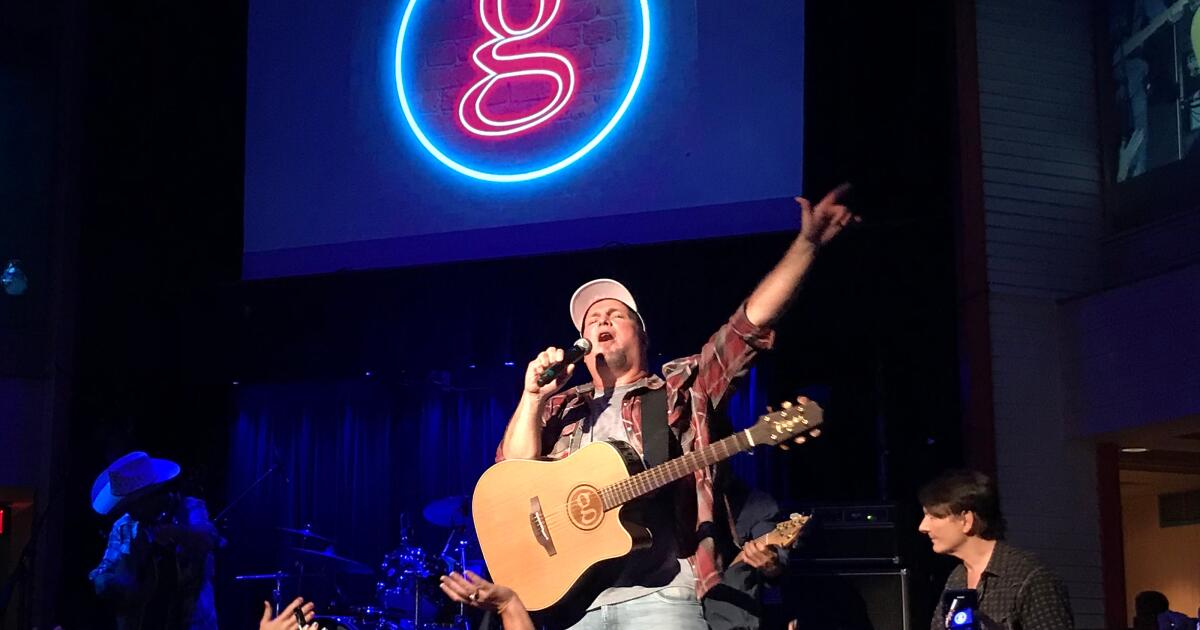

The famed Buck Owens Crystal Palace, where music legends including Willie Nelson, Dwight Yoakam, Garth Brooks and a young Taylor Swift have played, is up for sale, with the foundation that runs the Bakersfield venue planning to list it for $7 million on Monday.
The nightclub, museum and steakhouse was owned by its namesake Buck Owens, the country music trailblazer who bucked the slick commercial melodies of Nashville for a distinctly West Coast twang. Owens opened the Crystal Palace in 1996, watching it become a premier venue for the biggest names in country music, including himself. Buck and the Buckaroos played there every Friday and Saturday night until his death in 2006.
Jim Shaw, a member of the Buckaroos and a director of the Buck Owens Private Foundation, said that after 28 years of running the famed venue, the Owens family plans to step back and find new owners amid a challenging business climate. The foundation said in a statement that “since Buck’s passing in 2006, we’ve tried to maintain the excellence that he expected, even as it became more and more difficult during these challenging times of increasing food and labor costs.”
The venue is not closing and scheduled events will continue as planned, Shaw said.
“It’s business as usual for now,” Shaw said. “Ideally, someone who wants to keep it exactly as it is will come forward.”
Owens’ youngest son, Johnny Owens, wrote on Facebook that the family’s hope “is that a buyer steps forward with a vision for the future and a reverence” for his father and the Bakersfield Sound.
The Crystal Palace, located on Buck Owens Boulevard, is a major tourism staple for Bakersfield. The 18,000-square-foot venue is next to the city’s downtown entrance.
“It’s the No. 1 tourist attraction in Bakersfield,” Shaw said. “There are people stepping forward and we are waiting to see what happens. I am getting a lot of phone calls. I’m anxious to see what happens.”
World News
2nd local radio host says they were given questions ahead of Biden interview

A second local radio host on Saturday told ABC News that he was provided a list of questions in advance of his interview with President Joe Biden this week.
“Yes, I was given some questions for Biden,” Earl Ingram of CivicMedia told ABC News. Ingram, a prominent host of a Wisconsin radio station, interviewed Biden this week in the wake of his debate performance.
Ingram said he was given five questions and ended up asking four of them.
“I didn’t get a chance to ask him all the things I wanted to ask,” he said.
Ingram is the second interviewer who now says they were provided questions by Biden aides to ask the president this week. Earlier today, another local radio host who interviewed Biden this week told CNN she was given questions to ask Biden before the interview.
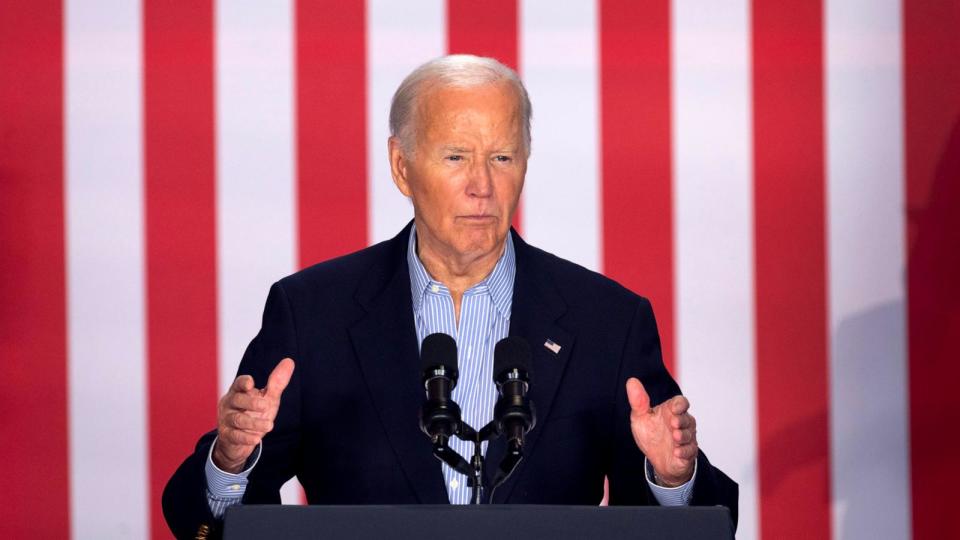

“We do not condition interviews on acceptance of these questions, and hosts are always free to ask the questions they think will best inform their listeners,” the Biden campaign told ABC News on Saturday.
Ingram told ABC he didn’t see anything necessarily wrong with the practice. “To think that I was gonna get an opportunity to ask any question to the President of the United States, I think, is a bit more than anybody should expect,” he said.
He continued that he was grateful for the opportunity to interview Biden at all.
“Certainly the fact that they gave me this opportunity … meant a lot to me,” Ingram said.
MORE: Wealthy Democratic donors sound alarm over Biden staying in race
On CNN earlier today, Andrea Lawful-Sanders, the host of WURD’s “The Source,” said Biden officials provided her with a list of eight questions ahead of their interview with Biden.
“The questions were sent to me for approval; I approved of them,” she said.
“I got several questions — eight of them,” she continued. “And the four that were chosen were the ones that I approved.”
Responding to Lawful-Sanders, Biden campaign spokesperson Lauren Hitt said in a statement that it’s not “uncommon” for interviewees to share topics they would prefer. She noted that Lawful-Sanders was “free” to ask any questions she saw fit. She also noted that it was the campaign who sent over the questions and not the White House as other reports claim.
Lawful-Sanders did note in her interview with CNN that she ultimately “approved” the questions provided.
“It’s not at all an uncommon practice for interviewees to share topics they would prefer. These questions were relevant to news of the day – the president was asked about this debate performance as well as what he’d delivered for black Americans,” the statement said.
“We do not condition interviews on acceptance of these questions, and hosts are always free to ask the questions they think will best inform their listeners. In addition to these interviews, the President also participated in a press gaggle yesterday as well as an interview with ABC. Americans have had several opportunities to see him unscripted since the debate.”
A source familiar with the Biden booking operation told ABC News that moving forward they will “refrain” from offering suggested questions to interviewers.
“While interview hosts have always been free to ask whatever questions they please, moving forward we will refrain from offering suggested questions.”
2nd local radio host says they were given questions ahead of Biden interview originally appeared on abcnews.go.com
-

 African History5 years ago
African History5 years agoA Closer Look: Afro-Mexicans 🇲🇽
-

 African History5 months ago
African History5 months agoBlack History Facts I had to Learn on My Own pt.6 📜
-

 African History5 years ago
African History5 years agoA Closer Look: Afro-Mexicans 🇲🇽
-

 African History1 year ago
African History1 year agoMajor African Tribes taken away during the Atlantic Slave Trade🌍 #slavetrade #africanamericanhistory
-

 African History1 year ago
African History1 year agoCameroon 🇨🇲 World Cup History (1962-2022) #football #realmadrid #shorts
-

 African History5 months ago
African History5 months agoBlack History Inventors: Mary Kenner 🩸
-

 African History1 year ago
African History1 year agoPROOF AFRICAN AMERICANS AIN'T FROM AFRICA DOCUMENTED EVIDENCE
-

 African History1 year ago
African History1 year agoNo African pre-Columbus DNA? 🤯🤯 #history #mesoamerica #mexico #african























